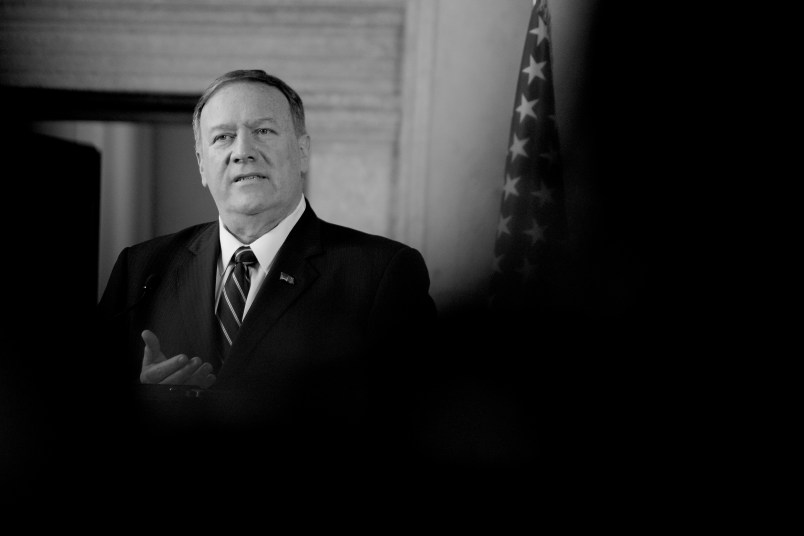As news of Iranian commander Quasem Soleimani’s killing spread, Secretary of State Mike Pompeo appeared on CNN last Friday morning to offer some explanation for the abrupt and inflammatory strike.
“I can’t talk too much about the nature of the threats, but the American people should know that President Trump’s decision to remove Qasem Soleimani from the battlefield saved American lives,” Pompeo said. “No doubt about that. He was actively plotting in the region to take ‘big action,’ as he described it, that would have put dozens if not hundreds of American lives at risk. We know it was imminent. This was an intelligence-based assessment that drove our decision making process.”
Thus, Pompeo laid down the “imminent threat” flag, the phrase the administration has since run with to explain why the strike was carried out without notifying the Gang of Eight, the odd timing of the attack and why it would green-light such an explosive move without any coordination with allies.
Sen. Lindsey Graham (R-SC), one of President Donald Trump’s closest allies, hadn’t yet gotten the memo when he went on Fox News that same morning to herald Trump’s strike and share that he’d been filled in about the attack in advance.
“I was briefed about the potential operation when I was down in Florida,” Graham on “Fox and Friends.” “I appreciate being brought into the orbit. I really appreciate President Trump letting the world know you cannot kill an American without [sic] impunity.”
His statement was at odds with the motivation Pompeo laid out. Pompeo painted the strike as a preventative measure to head off the “imminent threat” of a plot Soleimani was hatching to harm Americans in the region. Graham put a different patina on the situation, characterizing the attack as retaliation for Iranian-based attacks on the U.S. embassy in Baghdad on New Year’s Eve.
The senator quickly cleaned up his comments with a tweet.
We killed the most powerful man in Tehran short of the Ayatollah.
This was not an act of revenge for what he had done in the past.
This was a preemptive, defensive strike planned to take out the organizer of attacks yet to come.
— Lindsey Graham (@LindseyGrahamSC) January 3, 2020
But the imminent threat explanation is already back on shaky ground as the administration declines to give any meaningful details about Soleimani’s plotting.
Pompeo dodged timing specifics during a Sunday appearance on CNN’s “State of the Union,” telling anchor Jake Tapper that “if you’re an American in the region, days and weeks, this is not something that’s relevant. We have to prepare, we have to be ready, and we took a bad guy off the battlefield.”
Chairman of the Joint Chiefs Mark Milley too declined to give a solid timeline of the planned attacks.
The New York Times reported over the weekend that Pentagon officials offered Trump a whole host of options against Iran, tossing in killing of Soleimani as an extreme upper limit, to make the other actions more attractive. Trump reportedly wasn’t interested in the fatal drone strike until he watched the attack on the embassy unfold. By late Thursday, he shocked the officials by opting for the Soleimani attack.
Some Democratic lawmakers are sharing their doubts about the imminence of the threat after getting classified briefings on the situation.
“My staff was briefed by a number of people representing a variety of agencies in the United States government and they came away with no feeling that there was evidence of an imminent attack,” Sen. Tom Udall (D-NM) said Friday on CNN.
Sen. Chris Van Hollen (D-MD) sang the same tune.
“Nothing that came out of the briefing changed my view that this was an unnecessary escalation of the situation in Iraq and Iran,” he said on CNN Friday. “While I can’t tell you what was said, I can tell you, I have no additional information to support the administration’s claim that this was an imminent attack on Americans.”
Sen. Chris Murphy (D-CT) said on CBS’ “Face the Nation” Sunday that it is “incumbent” on the administration to “present evidence” and to “prove to us that by taking out the second most powerful political figure inside Iran, they are preventing more attacks rather than inspiring additional attacks.”
Chairman of the House Intel Committee Adam Schiff (D-CA) agreed that it’s “accurate” Soleimani was plotting to attack Americans in the region but that “it’s also true that Soleimani has been plotting against the United States for decades.”
“The question is, did the plotting here rise to the level that requires his elimination from the battlefield and would that elimination stop the plotting or would it accelerated it or would it make the potential attacks to the United States great or not worse?” he continued on CNN. “And there I don’t think the intelligence supports the conclusion that removing Soleimani increases our security.”







The wheels have fallen off the bus and are rolling down hill fast. And now Bibi is distancing himself from the Soleimani killing. Hmmm.
Endless lies.
So the relevant question is, “Were these imminent attacks likely to be more imminent than the ones we now expect after his assassination?”
“Imminent Threat.”
Pompeo and Trump must think the Soleimani strike was an episode of 24.
Starring Trump as Jack Bauer??
Please enlighten me.
I thought we didn’t target individuals so when we killed a target there was always some fig leaf of cover.
Happened to be in the compound etc…
Am I wrong?